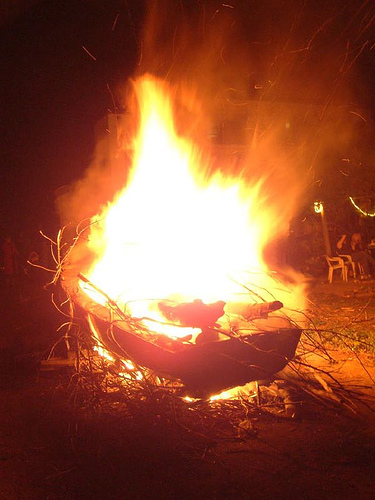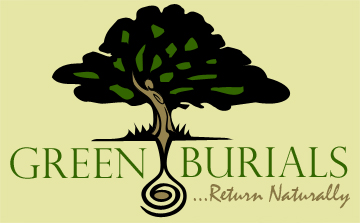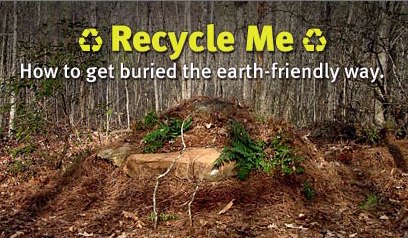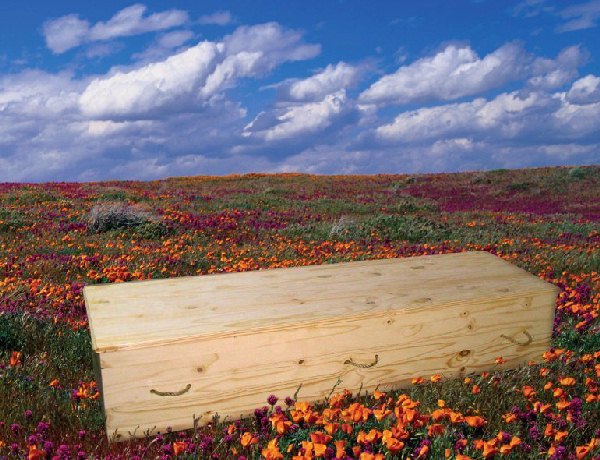|
|
|||||||||||||||||||||||||||||||
|
Green Burials
Do Your Bit Even After Death
By Shuchi Kalra - 2008. Millions of people die each day on this planet, leaving behind their carbon foot-prints. Each religion or community has its own way of cremating the dead, a ritual that rests on firm beliefs and is more or less an event just as a wedding or a new-birth in the family is. While burning the body is more common in Asia, burials are a norm in the West. Moreover, in the last century, countries like the U.S, U.K, Australia and Japan have seen a substantial rise in the rates on cremations with statistics going upto 70%. But there is one thing that all funerals have in common: the alarming amount of wood used in the pyres or the coffins. When the body is burnt along with kilos of wood and embalming fluids, an astonishing amount of carbon dioxide, sulfur dioxide and acids are produced; making the carbon footprint bigger and darker. Considering roughly one tree for every dead person, and a billion people dying each day: need I say more? You do the math! While burial does not involve any carbon dioxide emissions in the atmosphere, as does burning, it does involve acres of land which could be put to a more constructive use. A research conducted by Adelaide's Centennial Park found out that while a cremation process generates more than four times the carbon dioxide compared to a burial, the long term effects tell quite a different story. The maintenance of grave sites in terms of mowing, cutting, building, cleaning and watering leads to a greater expenditure of natural resources over the years. Bryan Elliott, who heads the research at Centennial Park, cites that each cremation and burial at Centennial Park generates approximately 160kg and 39 kg of carbon dioxide equivalent respectively. He also adds that the long-term impact of burials is about 10% more than that of cremations. According to him, "Burial is a more labor and resource intensive process, consumes more fuels and produces larger quantities of waste than cremation." These calculations and statistics are aimed a developing a carbon neutral program as the last rite. "Our initial research suggests that in order to offset the environmental footprint of burials and cremations at Centennial Park, we need to plant around one tree for each service," cited Elliot.
Thousands of square kilometers of land are devoted to cemeteries and crematoriums in each country while effective forest area is shrinking like a punctured balloon. The land allotted to cemeteries is never going to be used for anything else. Preserving forests and forest areas is the first and perhaps the only step humanity can take towards restoring the environment’s natural balance. Trees absorb carbon dioxide (the gas responsible for greenhouse effect) and give out oxygen (the gas we need to survive), so, by simple equation: there ought to be more trees than there are! An average person may not contribute to the green-house effect throughout his life as much as he does in his death. Our life-style does not allow us to live a totally natural existence but going “au natural” post-life is something all of us have a control on. Opting for a “Green Burial” is the least we can do to give back to Mother Earth what we have taken away from her. According to Professor Roger Short, an Australian scientist: “"The important thing is, what a shame to be cremated when you go up in a big bubble of carbon dioxide". In India, where Hinduism is the dominant religion, an average cremation requires 400 kilograms of wood to burn a body completely. According to Vinod Kumar Agarwal, the founder of Mokshda Environmental Group, “UN figures show close to 10 million people die a year in India. That leads to the felling of an estimated 50 million trees, leaves behind half a million tonnes of ash and produces eight million tonnes of carbon dioxide each year”. According to Agarwal, with proper and complete combustion, 22 kgs of wood should suffice in order to burn down a human body. But due to inefficient cremation methods, the amount of wood consumed increases multi-fold. He even devised an innovative design for a funeral pyre that allowed regulation of heat and circulation of air but due to religious concepts, the trend failed to catch on.
What is a green burial?
Green burial is a process wherein a body is returned to the soil in its most natural form sans any coffin or embalming agents. Manufacturing coffins requires cutting down of a large number of trees and the embalming fluids seep into the soil and pollute the water thus disturbing the ecosystem. The body may at the most be wrapped in a bio-degradable material like a sheet or a shroud. Another alternative would be to use a card-board box for a coffin and bury it under a tree in the wilderness. Nature takes its course and the decomposition of organic matter enriches the earth and nourishes plants which eventually contribute towards a healthier environment. This is how nature intended it to be. A tree is planted over the grave of the loved one and draws its nutrition from the decomposing organic matter. A green cemetery is a place where tombstones are replaced by trees and a forest is born, complete with wildlife, birds and flowers. There is no waste of natural resources like wood, water, pesticides or fertilizers. Nature takes it own course and your loved ones’ body is extended towards a noble cause making them immortal. Since a large chunk of forest area has been destroyed by human encroachment and consumption, green cemeteries come as a welcome change as they create miniature forest ecosystems within the cities and detoxify the atmosphere. The forest needs no maintenance or expense as it thrives on a soil made fertile by decaying organic matter. The biggest hurdle that stands in the way of Green Burial’s popularity and acceptance is the social mind-set and the hoard of superstitions that plague the society. Certainly no one can be forced into a green burial without the consent of the family and the will of the deceased; rather, it is a matter of personal choice which a person who prefers to live an environmentally sustainable life makes to do so even in death. Although people may differ on every issue, there is a hardly an individual who has no concern (big or small) for nature. Motivating the self and others around for making a eco-friendly choice is a gesture of love and respect to Mother Earth and it signifies that we are ready to give back all that she has given us all our lives! According to some religious sensibilities, a body can attain salvation only after it is burnt and is released from the cycle of reincarnation. What could provide more salvation than the awareness that we are returning where we came from and doing a lot of good in the process? Wouldn’t our souls rest in peace with a new-found pride that our bodies have nourished nature?
Even with contemporary techniques like “electrical crematoriums” and “elevated pyres” with chimneys to treat and filter the harmful gases, people have not embraced the idea of an environment friendly last rite. A strong religious influence and lack of awareness has a lot to do with it and that makes a “green burial” a very distant possibility. Nevertheless, change has to start from somewhere. It is understandable and obviously expected that after years of following conventional cremation and burial rites; some may not be open this tradition breaking idea. However, just as we are coming to accept organ donation, this concept too, is nothing out of the blue. In the former case, we are helping a human being while in the latter, we are helping nature. The cause is as noble, if not more, that the act of donating organs of your loved ones after their demise. Just like the donated organs are mentioned in the deceased’s will, so can the willingness to undergo a Green Burial. Choosing a Green Burial and discussing it with your family saves your loved ones from a lot of difficulties and hassles of making expensive and time-consuming arrangements for your last rites in their hour of grief. Every time a human dies, a tree does not have to die along with him/her. Life may often not give us an opportunity to prove our worth, but death certainly does! It is just a matter of “will”… "One's death should mean something." - Edward Abbey.
|
|
||||||||||||||||||||||||||||||
|
Website Design + SEO by designSEO.ca ~ Owned + Edited by Suzanne MacNevin | |||||||||||||||||||||||||||||||



